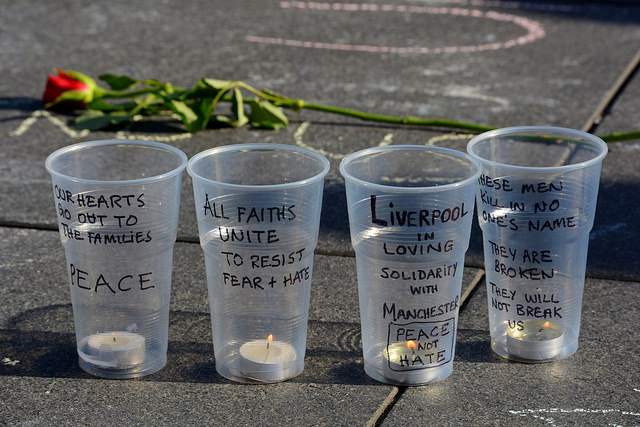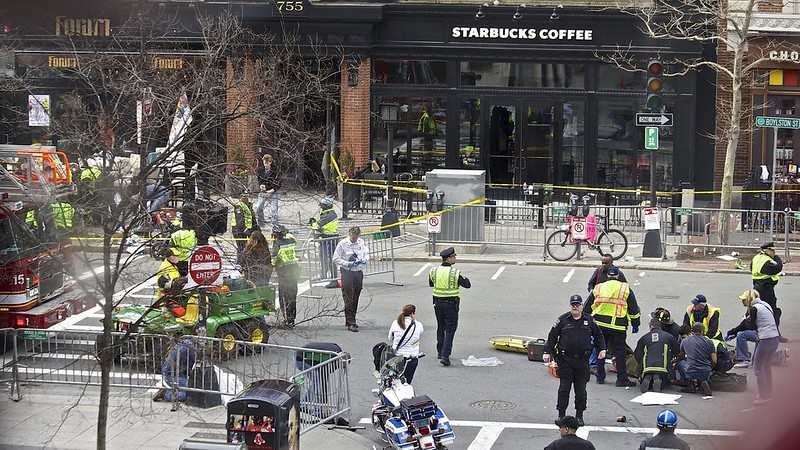What the Manchester Attack Shows Us About How the Terrorism Danger Has Evolved
The latest atrocity claimed by the Islamic State—the killing of at least 22 people, many of them children, at an Ariana Grande concert in Manchester—illustrates how the terrorism threat has evolved. The United Kingdom, after all, is no stranger to terrorism.

Published by The Lawfare Institute
in Cooperation With

The latest atrocity claimed by the Islamic State—the killing of at least 22 people, many of them children, at an Ariana Grande concert in Manchester—illustrates how the terrorism threat has evolved. The United Kingdom, after all, is no stranger to terrorism. On July 7, 2005 Al Qaeda attacked several transportation targets in London, killing 52, and Irish Republican Army attacks (IRA) regularly struck at the United Kingdom in the decades before Al Qaeda began attacking targets in Europe. Yet the Manchester attack, with its targeting of children and lack of a concrete link to a coherent political agenda, show how the danger posed by terrorism has changed over the years.
I frequently compare the risk of terrorism to the United States with that of past decades and argue that we typically overstate the current level of danger and that, in general, U.S. counterterrorism is performing admirably when it comes to defending the U.S. homeland. In the post-9/11 era, terrorists have killed 154 Americans in the U.S. homeland, with jihadists accounting for 95 of those. These numbers are lower than the average number of deaths within the United States in a comparable period for the pre-9/11 era. Even in Europe, the number of deaths and attacks in the post-9/11 era are lower than those in the pre-9/11 era, when groups like the IRA and Basque separatists waged a bloody war of attrition against the United Kingdom and Spain, respectively, and state sponsors like Iran and Libya committed attacks against their foes on European soil.
Numbers, however, only give us part of the picture when trying to understand the threat. Terrorist groups themselves have changed, altering the nature of the threat they pose. Some of these dangers concern the groups and their ideology, while others emanate from how they recruit, act, and thrive. Similarly, the U.S. and European response to terrorism has evolved, both for better and for worse.
The primary groups opposing the United States have grown increasingly radical. In the 1960s and 1970s, the United States faced an array of national liberation and left-wing movements, including some, such as the Viet Cong, that blended the two. Although such groups were often ruthless and vicious, their ultimate goal—self-determination—was comprehensible and even admirable to many Americans. Left-wing groups often represented more fringe voices, but they too had an ideology comprehensible to most Americans, and in many instances their actual use of violence was quite limited. In the 1980s, groups like the Lebanese Hizballah killed hundreds of Americans, but Hizballah attacked American troops and diplomats overseas—not the American people at home. Its state sponsors, such as Iran, made the group more formidable but also placed limits on the scope and scale of its attacks, recognizing that if it crossed too many lines the U.S. could react with devastating force. Brian Jenkins, one of the early pioneers in the study of terrorism, famously noted in 1988, “Thus far, terrorists seem to be more interested in having a lot of people watching, not a lot of people dead.”
This paradigm collapsed on 9/11, and the Islamic State has taken it at least one step further. Al Qaeda proved willing to kill thousands of civilians in its quest to intimidate the United States. So when considering the worst-case scenarios with regard to terrorism, especially jihadist terrorism, it is easy to let our imaginations run wild. Even though the group’s subsequent large-scale attacks were more akin to the worst of the 1970s and 1980s, the assumption remains that terrorists are bent on mass killing. Al Qaeda’s demands went beyond simple self-determination or political change and instead insisted the United States withdraw completely from the Middle East.
The Islamic State took this already extreme position and pushed it to the point of absurdity. The group embraces sexual slavery and bloody tactics such as beheadings as well as mass executions of Muslim minorities and Sunnis it considers disloyal. It seeks to create a caliphate, win a sectarian war in the region, and even bring on the apocalypse. Many terrorist groups would shy away from targeting a Ariana Grande type concert with an audience filled with children -- not the Islamic State. Even al Qaeda considers the Islamic State’s escalation in methods and objectives too extreme. The former top American Al Qaeda spokesman, the late Adam Gadahn, warned of “severe punishment” awaiting Islamic State fighters, both “in this world and the next,” for “the crimes [they have] committed against Muslims.” Clearly the stakes have been raised, when a group responsible for killing thousands of innocent civilians criticizes your actions as too violent. Islamic State and Al Qaeda-linked groups have often shot one another, rather than at their supposed enemies.
Because of this extremism, concessions to the broader population base on which terrorists drew proved important in fighting terrorism in the past but are far harder to make today. Pro-union policies and political parties favoring social freedoms that impressionable youth embraced often took the wind out of the radical left’s sails. Spain granted considerable autonomy to the Basque region, and the British government showered development spending on Northern Ireland while drafting a political deal that ensured Catholic rights. In the Middle East today, however, the radical constituencies do not want political reform even if the authoritarian regimes were willing to grant it, and they are likely to exploit any relaxation of police states’ security measures to expand their operations.
One bright spot is that in the post post-9/11 era, many groups do not share Al Qaeda’s emphasis on attacking the United States above all other targets. Although the Islamic State seeks to kill Americans and Europeans, and the Manchester attack is yet one more reminder that this is a genuine threat, the group’s primary focus is still on the Middle East. It seeks to defend and ideally expand its self-proclaimed caliphate. Combatting regional enemies—Hizballah, Turkey, Saudi Arabia, and so on—also consumes much of the group’s energy. This is in contrast to Al Qaeda, which devoted far more attention to striking the United States—what Bin Laden called “the head of the snake”—and its allies in the West. Al Qaeda is far weaker than it was on 9/11, and much of what is left of the group is more regional. Al Qaeda’s Syrian and most important affiliate, formerly known as Jabhat al-Nusra, announced it was severing ties with al Qaeda and would not attack the United States in the hopes of working more closely with (and eventually uniting) other Syrian opposition groups.
Yet even though Al Qaeda and the Islamic State’s focuses are more local and regional, their operations are vast. In the past, few groups could sustain a truly transnational presence, and if they did it often involved state support. Al Qaeda and the Islamic State, however, have local allies—what the Islamic State would call “provinces”—throughout the Muslim world. Operations by these groups draw attention to the group’s struggle and enable it to expand its influence. Al Qaeda’s affiliate in Yemen, for example, almost succeeded in downing a U.S. passenger plane in 2009, while the Islamic State’s province in the Sinai downed a Russian plane in 2015, killing 224 people.
Technological changes have made such vast operations more feasible. Terrorist groups can communicate—and thus direct recruits, proselytize, and raise money—far more easily and inexpensively than their predecessors. Anti-Soviet jihadists in Afghanistan struggled to produce a magazine that glorified their cause, and it took years for word of the struggle there to spread. A decade later, Al Qaeda leveraged developments in communication technology to command operatives around the world from its fastness in Afghanistan while issuing videos through the world’s media. Older groups also embrace information technology: Hizballah even operates a television station. The Islamic State put all this on steroids, disseminating a vast stream of propaganda in at least twenty languages and exploiting social media to recruit and direct its operatives, all from its base in Syria. The United Nations estimates that over 30,000 foreign fighters have gone to Iraq and Syria—more than all jihads in the past combined, in part due to the Islamic State’s unprecedented outreach.
Such technology has also enabled the Islamic State to aggressively employ so-called “Lone Wolves”—individuals not directly under the command of the group—to strike at the United States and Europe. Indeed, as the intrepid New York Times reporter Rukmini Callimachi has discovered, the Islamic State has used social media to provide at least limited guidance to many attackers overseas, bridging the historic gap between a top-down orchestrated attack and a Lone Wolf strike by an operative merely inspired by its ideology.
By far the biggest change, however, is the linkage between the terrorist groups and the control of territory. Hamas controls Gaza, Hizballah has de facto sovereignty over much of Lebanon, Al Qaeda affiliates like al Shabaab in Somalia rule over parts of their country, and of course the Islamic State at its peak in 2014 ruled lands roughly the size of Great Britain. Locals have regularly welcomed these groups even though they abhor their ideology, as years of civil war and anarchy leave many willing to embrace any form of law and order, no matter how extreme.
Such a shift toward governance is part of why these groups often have a more local and regional focus: having to run a government, enforce law and order, and provide services, even on a limited scale, is demanding in resources and time. In addition, groups often want to expand these havens, but since they are often under attack this kind of growth requires large military forces to assist in both defense and expansion. Defeating such terrorist groups is difficult because they have more supporters and engage in a wide range of activities beyond just terrorism. Hizballah is not just five guys in an underground cell seeking to construct a bomb: it also runs hospitals, schools, and government ministries.
It is difficult to disentangle discussion of the evolution of terrorism from developments in counterterrorism. In the post-9/11 era, the United States devotes billions of dollars and massive numbers of personnel to fighting terrorist groups—a dramatic shift. The United States directs a worldwide counterterrorism campaign that keeps terrorist groups off balance and less able to plot effectively. Such efforts tamp down the terrorism threat, making it hard to determine what the right level of spending and policy attention is. It is possible the United States is spending far too much to fight terrorist groups that are at best modest threats, but it is also possible that the massive U.S. counterterrorism effort is what has kept them modest.
Terrorism’s success, however, depends not just on the resources and attention of the government it opposes but also that government’s resilience—and here too the situation has changed, this time much for the worse. Since 9/11, keeping the U.S. homeland safe from mass casualty terrorism is an understandable priority by which every president should be judged. But the post-9/11 standard is not simply to avoid additional mass casualty attacks but rather to stop all attacks on Americans everywhere—an impossibly high bar. For today’s Americans this high bar seems obvious, but Ronald Reagan suffered no major political penalty (and people rightly see him as tough on terrorism) despite Hizballah attacks on U.S. Marines and diplomats in Lebanon that killed hundreds and the death of 270 people from Libya’s downing of Pan Am 103 in 1988. Americans are in no mood to accept that small attacks are difficult to prevent and that a low level of terrorism at home is a sign of success, not failure.
Finally, and most confusingly, the word “terrorism” is thrown about freely, often applied to insurgencies or rebel groups like the Taliban where the terrorism label fits poorly if at all and not applied to right-wing violence where the label fits quite well. So judging the risk by numbers of attacks or plots is difficult because a reduction in resources might allow a latent danger to quickly manifest. In addition, using the terrorism label often obscures the other dimensions of a group and why fighting it may require the United States to go beyond counterterrorism and use diplomatic and military tools commonly used against states.


-(1).jpg?sfvrsn=b91ff6a6_7)

.jpg?sfvrsn=d45482bc_5)
